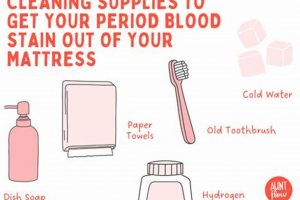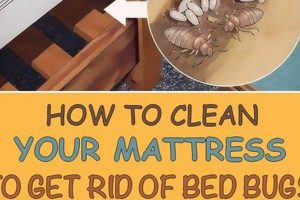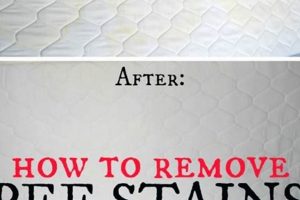Addressing fecal contamination on a mattress requires immediate and thorough cleaning to prevent staining, odor retention, and potential health hazards. The specific process involves several steps, including removing solid waste, disinfecting the affected area, and extracting moisture to prevent mold growth. The success of this process hinges on the promptness of the response and the effectiveness of the cleaning agents employed.
Effective remediation of mattress contamination is crucial for maintaining a sanitary sleep environment. Failure to properly address the situation can lead to lingering odors, the proliferation of bacteria, and potential allergic reactions. Historically, methods have ranged from simple surface cleaning to complete mattress replacement. Modern solutions emphasize deep cleaning and sanitization techniques to salvage the mattress whenever possible.
The subsequent sections will detail the necessary materials, a step-by-step cleaning procedure, and strategies for odor removal and stain prevention related to mattress contamination. These guidelines aim to provide a practical and efficient solution for restoring a mattress to a clean and usable condition.
Expert Tips for Mattress Decontamination
Effective strategies are required for successfully addressing instances of fecal contamination on a mattress. These tips provide practical guidance for sanitization and restoration.
Tip 1: Immediate Action: Prompt removal of solid matter is crucial. Use disposable gloves and paper towels to carefully collect and dispose of any fecal material present on the mattress surface. Minimize spreading to prevent further contamination.
Tip 2: Enzyme-Based Cleaners: Utilize an enzyme-based cleaner specifically designed for organic stains. These cleaners break down the proteins in fecal matter, aiding in effective removal. Follow the product instructions carefully, ensuring adequate dwell time for optimal results.
Tip 3: Blot, Do Not Rub: When applying cleaning solutions, employ a blotting technique rather than rubbing. Rubbing can spread the stain and force the contamination deeper into the mattress fibers. Use a clean cloth or paper towel to gently blot the area until moisture is absorbed.
Tip 4: Hydrogen Peroxide Solution: For stubborn stains, a 3% hydrogen peroxide solution can be applied. Test in an inconspicuous area first to ensure colorfastness. Apply sparingly, blot, and allow to air dry completely. Be cautious with darker colored mattresses.
Tip 5: Baking Soda Deodorization: After cleaning, generously apply baking soda to the affected area. Baking soda is an effective odor absorbent. Allow it to sit for several hours, or preferably overnight, before vacuuming thoroughly.
Tip 6: Professional Steam Cleaning: Consider professional steam cleaning services for severe contamination. Steam cleaning can penetrate deep into the mattress, removing embedded stains and odors. Ensure the service uses appropriate sanitizing agents.
Tip 7: Mattress Protector: Following cleaning, invest in a high-quality waterproof mattress protector. This will provide a barrier against future accidents and help maintain the cleanliness of the mattress.
Implementing these techniques minimizes the long-term impact of mattress contamination, promoting hygiene and extending the life of the mattress.
The following sections provide details on preventative measures and maintenance to ensure a hygienic sleep environment.
1. Immediate waste removal
Prompt elimination of solid or semi-solid fecal matter represents the initial and most critical step in mitigating the impact of diarrheal contamination on a mattress. The effectiveness of all subsequent cleaning procedures depends heavily on the thoroughness and speed with which this initial removal is executed.
- Prevention of Deeper Penetration
Rapid removal minimizes the opportunity for liquid components of the diarrhea to seep deeper into the mattress fibers. Capillary action can draw contaminants into the mattress’s core, making subsequent cleaning far more difficult and potentially compromising the mattress’s structural integrity. Acting swiftly limits this absorption, confining the contamination to the surface layers.
- Minimizing Stain Formation
Pigments and other staining agents present in fecal matter can quickly bind to mattress fibers, particularly if left unattended. Immediate removal reduces the contact time between these substances and the mattress material, lessening the likelihood of permanent or difficult-to-remove stains. This preservation of the mattress’s aesthetic appearance contributes significantly to its overall lifespan.
- Reducing Odor Development
Fecal matter contains volatile organic compounds (VOCs) that are responsible for its characteristic odor. The longer these compounds remain in contact with the mattress, the more they will be absorbed into the fibers, leading to persistent and potentially unpleasant smells. Prompt removal significantly reduces the concentration of these VOCs, preventing long-term odor issues.
- Limiting Bacterial Proliferation
Diarrhea often contains bacteria and other microorganisms that can thrive in the warm, moist environment of a mattress. These microorganisms can contribute to odor and potentially pose a health risk. Immediate waste removal significantly reduces the nutrient source available to these microbes, limiting their growth and preventing the spread of potentially harmful bacteria.
The significance of immediate waste removal as it relates to successfully mitigating the impact of diarrheal contamination is underscored by its multifaceted benefits. This initial action sets the stage for all subsequent cleaning efforts, influencing the extent of staining, odor development, and potential microbial growth. A failure to promptly address the contamination significantly reduces the likelihood of fully restoring the mattress to a sanitary and usable condition.
2. Enzyme cleaner application
Enzyme cleaner application represents a critical step in the remediation of diarrheal contamination on a mattress. These specialized cleaners contain enzymes specifically formulated to break down the complex organic compounds present in fecal matter, facilitating removal and minimizing lasting damage.
- Targeted Breakdown of Organic Matter
Enzyme cleaners contain enzymes such as proteases, amylases, and lipases. These enzymes catalyze the breakdown of proteins, starches, and fats, respectively, which are major components of fecal matter. This targeted degradation transforms complex molecules into smaller, more water-soluble compounds that are easily lifted from the mattress fibers. The specificity of this action distinguishes enzyme cleaners from general-purpose cleaning agents.
- Odor Neutralization
The characteristic odor associated with diarrhea stems from volatile organic compounds produced by bacterial decomposition. Enzyme cleaners not only remove the source of these odors by breaking down the fecal matter but also can contain enzymes that directly neutralize odor-causing molecules. This two-pronged approach provides a more effective and longer-lasting odor control compared to masking agents or disinfectants alone. Example: Uric acid is a major source of odor in organic waste; specific enzymes target and break down the uric acid molecule.
- Reduced Chemical Residue
Compared to harsh chemical cleaners, enzyme cleaners are generally considered safer for both the user and the environment. They leave behind minimal chemical residue after application and are less likely to damage the mattress fibers. This is particularly important for mattresses used by individuals with sensitivities or allergies. The reduced chemical load minimizes the risk of irritation or allergic reactions.
- Enhanced Stain Removal
Enzyme cleaners improve stain removal by solubilizing the components of the stain and preventing them from re-depositing onto the mattress fibers. The enzymes break down the complex stain molecules, making them easier to lift away during the blotting or extraction process. In contrast, some chemical cleaners can set stains if not used correctly. Example: Using an enzyme cleaner before steam cleaning can pretreat and loosen stains, maximizing the steam cleaner’s effectiveness.
The strategic application of enzyme cleaners addresses multiple challenges associated with addressing fecal matter on a mattress. Its ability to specifically target and break down organic matter, neutralize odors, minimize chemical residue, and enhance stain removal contribute to a thorough and effective cleaning process that promotes both hygiene and mattress longevity.
3. Blotting technique
In the context of fecal matter removal from a mattress, the blotting technique is an essential method for minimizing stain spread and preventing deeper contamination of the mattress fibers. This technique, characterized by gentle pressing and lifting motions, contrasts with rubbing, which can force the contaminating material further into the mattress structure. The cause-and-effect relationship is direct: rubbing increases the surface area of contamination and forces the liquid deeper, whereas blotting lifts the liquid away, reducing both stain size and penetration depth. The blotting technique is a necessary component because it maintains the integrity of the mattress while removing the contaminant.
A practical example illustrates the importance of this technique. Consider two identical instances of diarrhea on a mattress. In one case, rubbing is employed in an attempt to clean the spill. This results in a larger, more diffuse stain and odor due to deeper penetration of the contaminant. In the other case, blotting is used with absorbent cloths. The stain remains localized, and subsequent cleaning efforts are more effective because the fecal matter has not been forced deeper into the mattress padding. The blotting method ensures that applied cleaning agents primarily lift the staining material rather than spreading it further.
In summary, the blotting technique’s effectiveness in the context of removing fecal contamination from a mattress is due to its ability to minimize stain spread and penetration. The understanding of the detrimental effects of rubbing and the benefits of blotting is essential for successful mattress remediation. Challenges may include the time and patience required for thorough blotting, but this is a necessary investment to prevent long-term damage and odor retention. The blotting technique, when appropriately applied, significantly enhances the overall effectiveness of cleaning, supporting both the sanitary condition and longevity of the mattress.
4. Hydrogen peroxide testing
The application of hydrogen peroxide in the process necessitates a preliminary testing phase to avert potential damage to the mattress fabric. This testing phase is a preventive measure to ascertain the colorfastness of the material. Diarrheal matter contains compounds that, when combined with hydrogen peroxide, may trigger discoloration or bleaching, especially in darker or more delicate fabrics. Therefore, a small, inconspicuous area of the mattress is treated with hydrogen peroxide to observe any adverse reactions before broader application.
An example illustrates the practical significance of hydrogen peroxide testing. A dark-colored mattress might exhibit noticeable bleaching if hydrogen peroxide is applied directly without testing. The test application provides insight into the mattress’s reaction. If no color change is observed, the hydrogen peroxide solution is deemed safe for treating the affected area. If color change occurs, alternative cleaning methods that are less aggressive are investigated to prevent aesthetic damage. In such situations, enzyme-based cleaners or milder detergents are considered as safer alternatives.
Hydrogen peroxide testing is a crucial preceding step in the cleaning regime. Testing ensures the hydrogen peroxide solution is appropriate, prevents unintended mattress discoloration or damage, and preserves the mattress’s integrity. The carefulness required in the process underscores the importance of informed decisions, balancing cleaning effectiveness with the necessity of avoiding irreversible fabric damage. In addressing how to clean fecal matter, hydrogen peroxide represents a potent but potentially damaging option; its responsible application necessitates preliminary testing.
5. Baking soda deodorization
Following the removal of solid waste and application of cleaning agents, baking soda deodorization serves as a critical step in mitigating residual odors associated with fecal contamination on a mattress. This process leverages baking soda’s inherent properties to neutralize lingering smells and restore a hygienic sleep environment.
- Absorption of Volatile Compounds
Baking soda (sodium bicarbonate) possesses a porous structure that enables it to absorb volatile organic compounds (VOCs), which are primary contributors to fecal malodor. By capturing these airborne molecules, baking soda effectively reduces the concentration of odor-causing substances, thereby diminishing the intensity of the smell. This absorption mechanism is a physical process, not a chemical reaction, which makes it a safe and environmentally friendly deodorizing agent. Baking soda effectively absorbs smells associated with fecal contamination, resulting in a more neutral-smelling mattress.
- Neutralization of Acidic Odors
Fecal matter often contains acidic compounds that contribute to its characteristic smell. Baking soda is a mild alkali that can neutralize these acidic molecules through a chemical reaction. This neutralization process transforms the acidic odors into less volatile, odorless compounds. For instance, butyric acid, a common fatty acid found in feces, can be neutralized by baking soda, reducing its contribution to the overall odor profile. This chemical interaction helps to eliminate rather than simply mask the odor.
- Moisture Absorption
Residual moisture within the mattress can harbor bacteria and promote the release of odors. Baking soda’s hygroscopic properties enable it to absorb excess moisture from the mattress fibers. This moisture absorption creates a less favorable environment for bacterial growth and prevents the release of odor-causing compounds. A dry mattress is less prone to developing lingering smells. Baking soda aids by absorbing excess moisture that cleaning and fecal matter can leave behind.
- Safe and Non-Damaging Application
Compared to many chemical deodorizers, baking soda is a relatively inert substance that is unlikely to damage or discolor mattress fabrics. Its gentle nature allows for liberal application without the risk of adverse effects. This is especially important for delicate mattress materials that could be harmed by harsh chemicals. Furthermore, baking soda is safe for use around children and pets, minimizing potential health risks associated with residue exposure. Baking soda avoids discoloring material and harming the mattress.
These various facets of baking soda deodorization underscore its importance in the comprehensive process. Effective application, allowing sufficient contact time and thorough vacuuming afterward, will contribute significantly to removing odors from a mattress contaminated by fecal matter. Baking soda deodorization complements preceding cleaning steps and facilitates the full restoration of a sanitary sleeping surface.
6. Professional steam cleaning
Professional steam cleaning is often employed as a final measure for remediating mattress contamination, particularly in cases involving fecal matter. Its high-temperature cleaning action penetrates deep into mattress fibers, addressing embedded stains and odors that surface treatments may fail to eliminate.
- High-Temperature Sanitization
Steam cleaning utilizes high-temperature steam to sanitize mattress fibers, effectively killing bacteria, viruses, and other microorganisms present within the mattress. Temperatures typically reach levels that denature proteins and disrupt the cell membranes of pathogens, thereby providing a thorough disinfection. The application of heat helps ensure the removal of pathogens that are often associated with fecal contamination.
- Deep Stain Extraction
The pressurized steam forces hot water into the mattress, loosening embedded dirt and stains. Simultaneously, a powerful vacuum extracts the water along with the dissolved contaminants. This extraction process removes stain residues and minimizes the potential for mold growth by reducing moisture content. High-pressure extraction can effectively target and remove stains left by diarrhea.
- Odor Elimination at the Source
Steam cleaning directly addresses the source of odors by eliminating odor-causing bacteria and removing residual fecal matter from the mattress fibers. The high temperature of the steam disrupts the molecular structure of volatile organic compounds responsible for unpleasant smells, leading to their breakdown and removal. The steam cleaning effectively eliminates the root cause of the smell of fecal contamination.
- Reduced Chemical Residue
Professional steam cleaning typically relies solely on the power of steam and hot water, reducing or eliminating the need for harsh chemical cleaning agents. This minimizes the risk of chemical residue remaining within the mattress, which can be particularly important for individuals with sensitivities or allergies. Steam cleaning offers a way to clean and sanitize a mattress without leaving harsh chemicals behind.
The combined sanitizing, stain extracting, odor eliminating, and chemical minimizing benefits of professional steam cleaning establish it as a viable option for severe or persistent instances of fecal matter. While DIY cleaning approaches may suffice for minor incidents, professional steam cleaning offers a comprehensive and effective method for restoring mattresses to a sanitary and usable condition.
Frequently Asked Questions
The following addresses common concerns regarding the effective removal of fecal matter and associated stains and odors from mattresses, presenting factual information and established best practices.
Question 1: How quickly must cleaning begin after diarrheal contamination occurs?
Immediate action is crucial. Delay allows for deeper penetration of the fecal matter into the mattress fibers, increasing the difficulty of subsequent cleaning and elevating the risk of persistent stains and odors.
Question 2: What types of cleaning agents are most effective against diarrheal stains?
Enzyme-based cleaners specifically formulated for organic stains are recommended. These cleaners break down the proteins and other complex molecules found in fecal matter, facilitating their removal. Standard household cleaners are generally less effective.
Question 3: Is it possible to fully eliminate the odor of diarrhea from a mattress?
Complete odor elimination is achievable through a combination of thorough cleaning, enzyme cleaner application, and deodorization techniques such as baking soda treatment. Professional steam cleaning may be required for severe cases.
Question 4: Can the application of heat, such as from a hairdryer, aid in the drying process after cleaning?
While heat can accelerate drying, it is generally not recommended due to the potential for setting stains and damaging mattress fibers. Air drying or the use of a fan is preferable.
Question 5: How can future instances of mattress contamination be prevented?
The use of a high-quality, waterproof mattress protector is strongly advised. This provides a barrier against spills and accidents, preventing contaminants from reaching the mattress itself.
Question 6: When is it necessary to discard a mattress following diarrheal contamination?
If thorough cleaning and deodorization attempts prove unsuccessful, or if the contamination is extensive and has penetrated deep into the mattress core, disposal may be the most hygienic option.
Effective mattress decontamination following diarrheal contamination requires swift and decisive action, employing appropriate cleaning agents and techniques. While complete restoration is often possible, severe cases may necessitate professional intervention or mattress replacement.
The subsequent section will explore specific product recommendations and offer guidance on selecting appropriate cleaning supplies for mattress decontamination.
Conclusion
The preceding discussion addressed the multifaceted challenges associated with fecal contamination on a mattress. Initial actions, including prompt waste removal and targeted enzyme cleaner application, play a critical role in mitigating stain and odor development. Techniques such as blotting and subsequent deodorization with baking soda contribute to a cleaner, more sanitary outcome. When these methods are insufficient, professional steam cleaning represents a viable solution for deep sanitization.
Effective remediation minimizes health risks and prolongs the lifespan of the mattress. Addressing this situation requires a methodical approach that balances immediate intervention with appropriate cleaning protocols and preventive measures. Adherence to these principles facilitates a hygienic sleep environment and reduces the necessity for costly mattress replacement.







